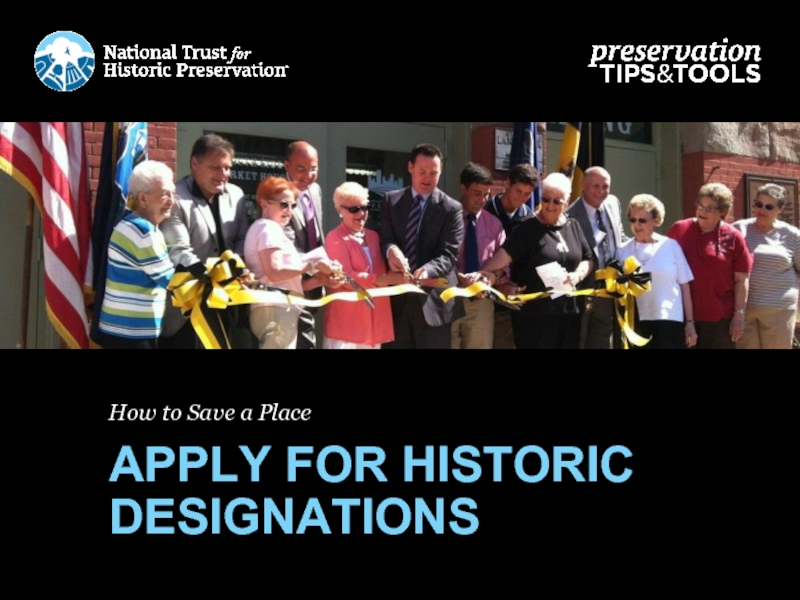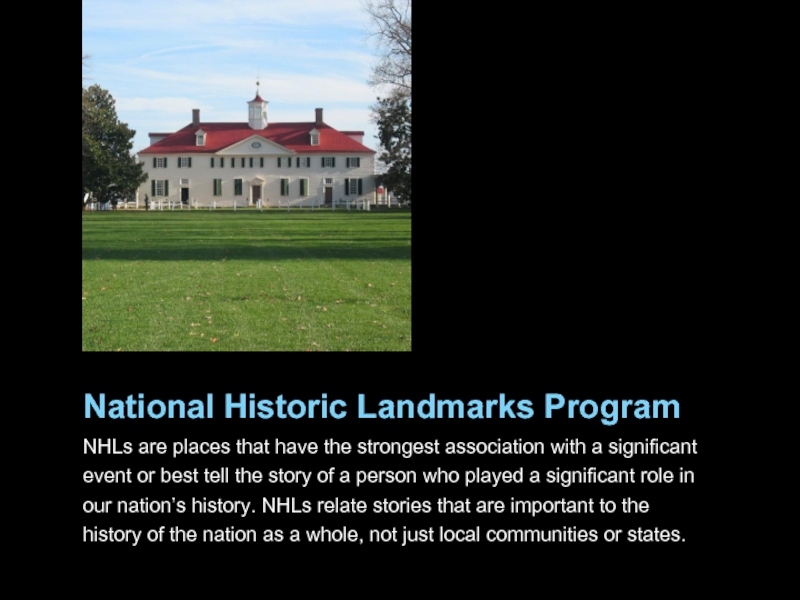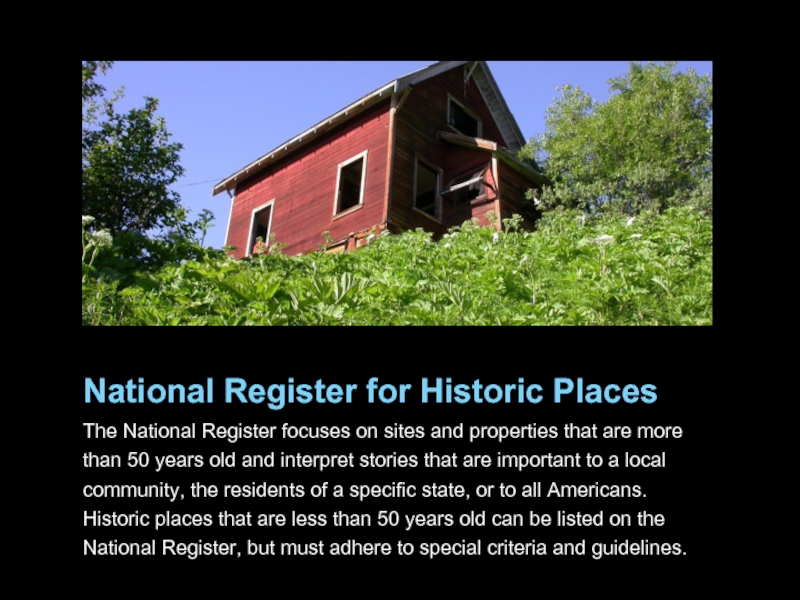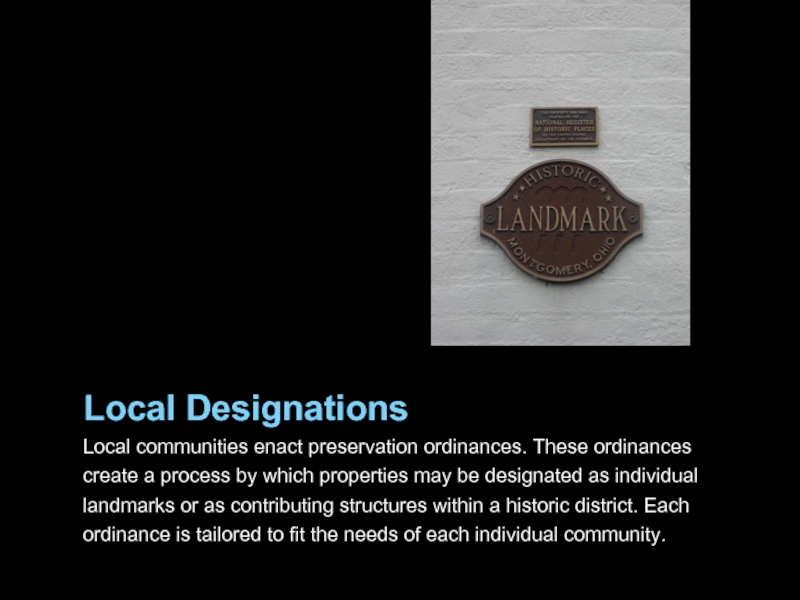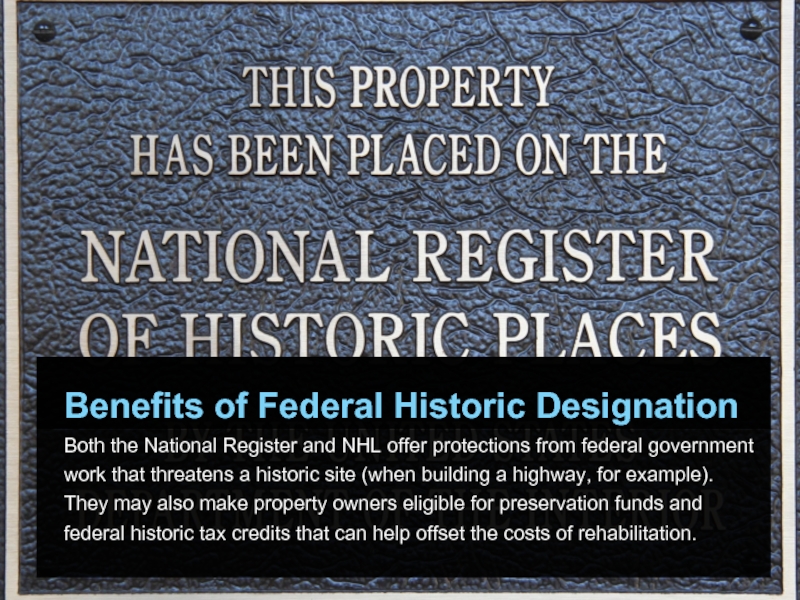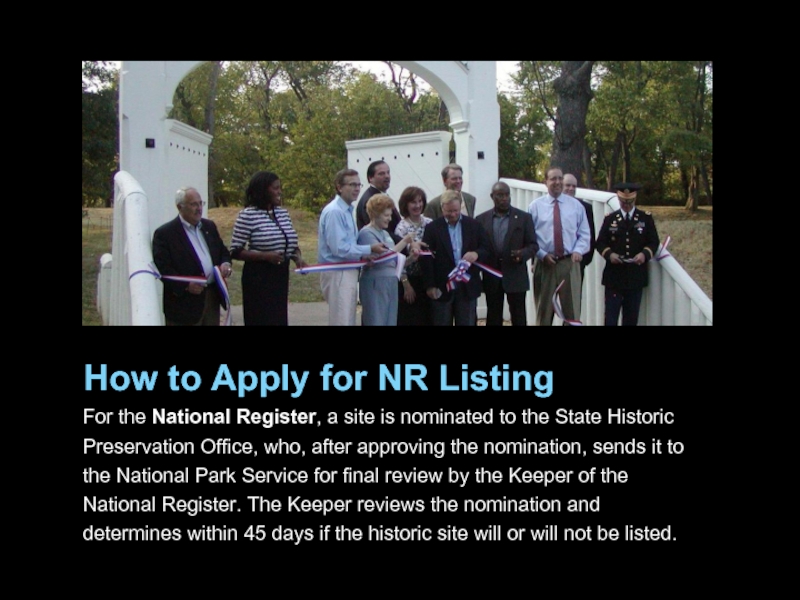- Главная
- Разное
- Дизайн
- Бизнес и предпринимательство
- Аналитика
- Образование
- Развлечения
- Красота и здоровье
- Финансы
- Государство
- Путешествия
- Спорт
- Недвижимость
- Армия
- Графика
- Культурология
- Еда и кулинария
- Лингвистика
- Английский язык
- Астрономия
- Алгебра
- Биология
- География
- Детские презентации
- Информатика
- История
- Литература
- Маркетинг
- Математика
- Медицина
- Менеджмент
- Музыка
- МХК
- Немецкий язык
- ОБЖ
- Обществознание
- Окружающий мир
- Педагогика
- Русский язык
- Технология
- Физика
- Философия
- Химия
- Шаблоны, картинки для презентаций
- Экология
- Экономика
- Юриспруденция
Apply for Historic Designations презентация
Содержание
- 1. Apply for Historic Designations
- 2. Federal Designations Federal designations include the National
- 3. National Historic Landmarks Program NHLs are
- 4. National Register for Historic Places The National
- 5. State Designations Historic properties or sites can
- 6. Local Designations Local communities enact preservation
- 7. NOTE: In general, a historic site can have local, state, and federal designations.
- 8. Benefits of Federal Historic Designation Both the
- 9. Benefits of State Historic Designation Listing on
- 10. Benefits of Local Designation Local preservation ordinances
- 11. Note: Although the National Park Service manages
- 12. How to Apply for NHL Listing For
- 13. How to Apply for NR Listing For
- 14. Note: Remember, if you are nominating a
- 15. How to Apply for Local Designation At
- 16. Photos courtesy: Emily Farah, Essential Public Radio;
Слайд 2Federal Designations
Federal designations include the National Historic Landmarks (NHL) Program and
listing on the National Register for Historic Places (NR or National Register). Both the National Historic Landmarks Program and the National Register for Historic Places are managed by the National Park Service.
Слайд 3National Historic Landmarks Program
NHLs are places that have the strongest
association with a significant event or best tell the story of a person who played a significant role in our nation’s history. NHLs relate stories that are important to the history of the nation as a whole, not just local communities or states.
Слайд 4National Register for Historic Places
The National Register focuses on sites and
properties that are more than 50 years old and interpret stories that are important to a local community, the residents of a specific state, or to all Americans. Historic places that are less than 50 years old can be listed on the National Register, but must adhere to special criteria and guidelines.
Слайд 5State Designations
Historic properties or sites can be listed on a state
register, which is managed by the State Historic Preservation Office (SHPO). Not all states have registers, so contact your SHPO to learn the ins-and-outs of your state’s policies.
Слайд 6Local Designations
Local communities enact preservation ordinances. These ordinances create a
process by which properties may be designated as individual landmarks or as contributing structures within a historic district. Each ordinance is tailored to fit the needs of each individual community.
Слайд 8Benefits of Federal Historic Designation
Both the National Register and NHL offer
protections from federal government work that threatens a historic site (when building a highway, for example). They may also make property owners eligible for preservation funds and federal historic tax credits that can help offset the costs of rehabilitation.
Слайд 9Benefits of State Historic Designation
Listing on the state register protects a
historic place from state government work and makes it eligible for state funding and tax benefits.
Слайд 10Benefits of Local Designation
Local preservation ordinances are one of the best
forms of legal protection a historic place can have because they protect it from local zoning and development laws. They also give property owners more confidence in the long-term stability of the neighborhood.
Слайд 11Note:
Although the National Park Service manages the NHL and the National
Register, each has a different application process.
Слайд 12How to Apply for NHL Listing
For the NHL program, the owner,
a preservation organization, or an interested member of the general public must nominate the property. After NHL staff reviews and approves the nomination, it passes to the Landmarks Committee, which then reviews, approves, and recommends the nomination to the Secretary of the Interior, which makes the final call for NHL designation. The process can take anywhere from two to five years.
Слайд 13How to Apply for NR Listing
For the National Register, a site
is nominated to the State Historic Preservation Office, who, after approving the nomination, sends it to the National Park Service for final review by the Keeper of the National Register. The Keeper reviews the nomination and determines within 45 days if the historic site will or will not be listed.
Слайд 14Note:
Remember, if you are nominating a historic site and you are
not the property owner, it is always a good idea to communicate your preservation interests to the owner, as well as how those interests can benefit them in a variety of ways. Establishing pleasant relationships with owners of historic sites earlier on can make the designation process smoother later.
Слайд 15How to Apply for Local Designation
At the local level, it is
imperative to first review the historic preservation ordinance in the area. It will explain the community’s unique criteria for a property to be designated as historic, as well as the review process.
Because each ordinance is site-specific, it’s difficult to summarize a “one size fits all” process. Generally, you initiate an application for historic designations, and then prepare a well-researched argument for the local preservation commission to review at a public hearing, where they will give their recommendations and/or approval for designations.
Because each ordinance is site-specific, it’s difficult to summarize a “one size fits all” process. Generally, you initiate an application for historic designations, and then prepare a well-researched argument for the local preservation commission to review at a public hearing, where they will give their recommendations and/or approval for designations.
Слайд 16Photos courtesy: Emily Farah, Essential Public Radio; Slick-o-Bot, Wikimedia Commons; Adam
Fagen, Flickr; NPS Cultural Landscape Program, Flickr; Don Shall, Flickr; Ed!, Wikimedia Commons; Jonathunder, Wikimedia Commons; Rauglothgor, Wikimedia Commons; Orange County Archives, Flickr; Alan Levine, Flickr; U.S. Army Corps of Engineers, Flickr.
